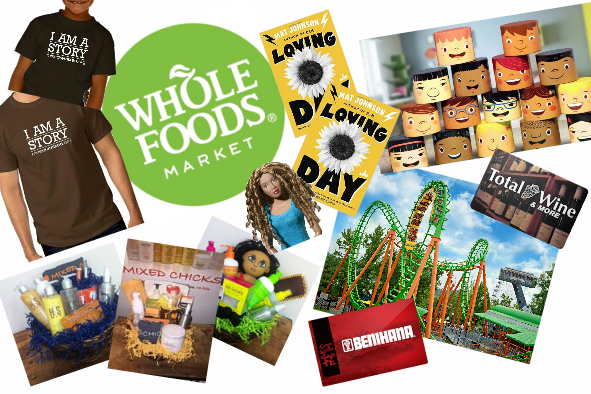 We’re looking for your ideas about who should receive the 2017 Storyteller’s Prize at the Mixed Remixed Festival next year. We have a stellar list of distinguished past honorees including: Key & Peele, Taye Diggs and Shane Evans, Al Madrigral, Susan Straight, Jamie Ford, Cheerios and Honey Maid. Who do you think we should consider? Let us know and list your ideas here.
We’re looking for your ideas about who should receive the 2017 Storyteller’s Prize at the Mixed Remixed Festival next year. We have a stellar list of distinguished past honorees including: Key & Peele, Taye Diggs and Shane Evans, Al Madrigral, Susan Straight, Jamie Ford, Cheerios and Honey Maid. Who do you think we should consider? Let us know and list your ideas here.
Multiracial Americans Gather to Tell Their Stories To Create Spaces for Healing & Activism
Multiracial Americans Gather to Tell Their Stories To Create Spaces for Healing & Activism
By Michele Beller
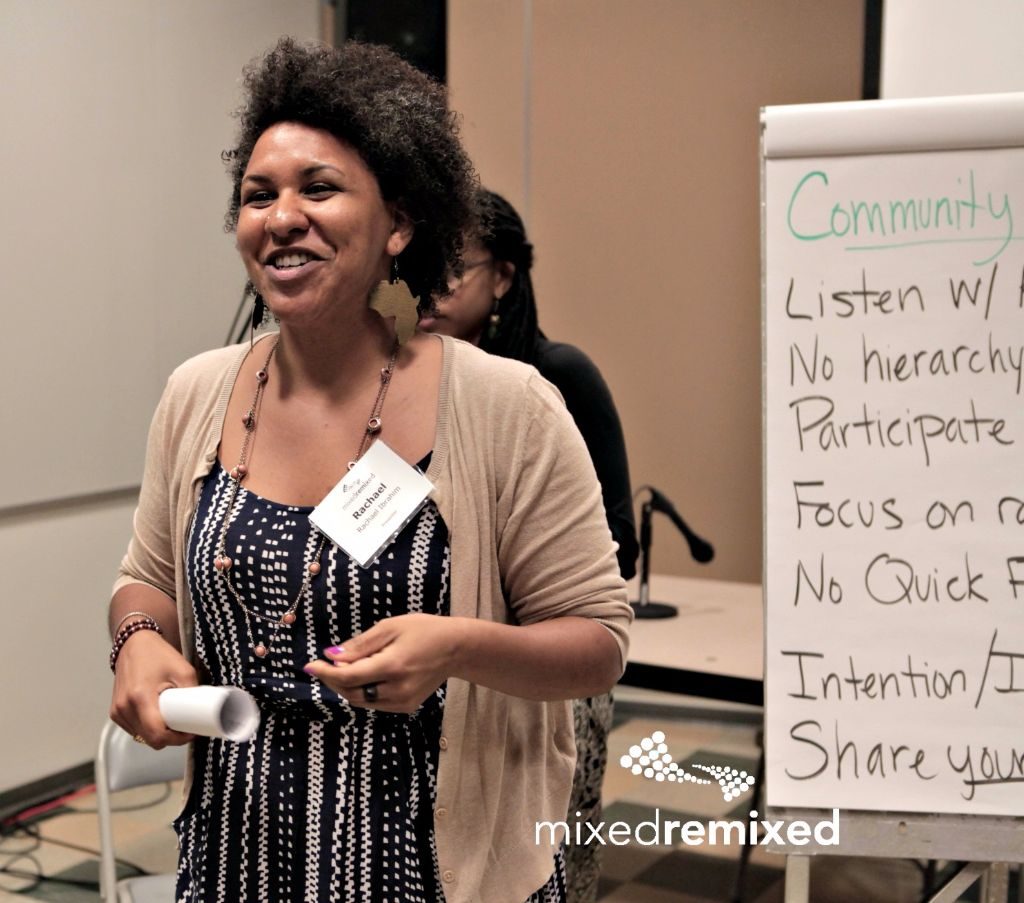 One of the most dynamic workshops of my day at the 2016 Mixed Remixed Festival this year was the Storytelling: Art and Activism Unite workshop with Amity Paye and Rachel Ibrahim, MSW. “Storytelling is a powerful, historical, cultural practice that has the ability to create social change,” they pointed out, and “as mixed race people, we have many stories to tell.” Amity, who works in communications at a labor union and has written extensively for various publications including The Nation, NBC, and The Root, and Rachel, a community organizer, trainer and artist, are a dynamic duo. Together they organize and facilitate conversations such as this across the U.S., through many venues.
One of the most dynamic workshops of my day at the 2016 Mixed Remixed Festival this year was the Storytelling: Art and Activism Unite workshop with Amity Paye and Rachel Ibrahim, MSW. “Storytelling is a powerful, historical, cultural practice that has the ability to create social change,” they pointed out, and “as mixed race people, we have many stories to tell.” Amity, who works in communications at a labor union and has written extensively for various publications including The Nation, NBC, and The Root, and Rachel, a community organizer, trainer and artist, are a dynamic duo. Together they organize and facilitate conversations such as this across the U.S., through many venues.
This day, we would be working not just on sharing our multiracial stories but on sharing them in a way that would build accountability, interrupt oppression, address anti-blackness, and, importantly, creating spaces for healing. In doing this, we would help lift up strategies to strengthen communities and promote social justice and racial equity, the pair explained. As they discussed the packed agenda for the next hour, attendees in the large group looked eager to get started.
Coming Together to Share as a Mixed Community
The first order of business was a Community Agreement to help build a team/community, and after all agreed, the doors would be shut and we’d be ready to dig in. The contents of the Agreement are worth noting, and something good to remember for future.
First on the Agreement: “Listen with respect.” Here, Rachael paused to give us a fun puzzle to solve: “What else does listen spell when the letters are rearranged?” she asked. (I got this! I got this! NPR’s Puzzlemaster Will Shortz would be proud!) Answer: Silent! What a good reminder of how to listen—silence your inner dialogue as you listen to others.
Number two on the list was “No hierarchy of oppression” (whose oppression is worse that another’s? Answer: Not applicable—who is to judge?).
Third on the Agreement was “Participate” (move up or move back, depending on your habit of jumping in or sitting back.) Here, Rachael asked for a show of hands: first, those who are quick to jump in and comment or participate. Second, those who would prefer to sit back and observe rather than participate were asked to raise their hands. As the second group identified themselves, Rachael grinned and quipped, “Wonderful; we’ll call on you first.” The entire room broke out in laughter. She was kidding, of course, but you get an idea of what dynamic workshop leaders these two are and how skilled they are at putting everyone at ease.
 Next on the list was: “The focus today stays on racism in the U.S.–this mostly to narrow it down a bit accounting for the short time we had for the workshop. There are so many isms and so many issues, it can be overwhelming. And this point is a perfect segue way to the next item on the list: “Recognition that there is no ‘quick fix.’” (Whew! Pressure’s off! We wouldn’t have to solve all the country’s problems in this coming hour!).
Next on the list was: “The focus today stays on racism in the U.S.–this mostly to narrow it down a bit accounting for the short time we had for the workshop. There are so many isms and so many issues, it can be overwhelming. And this point is a perfect segue way to the next item on the list: “Recognition that there is no ‘quick fix.’” (Whew! Pressure’s off! We wouldn’t have to solve all the country’s problems in this coming hour!).
Another important item was “Intention/Impact.” Here, the idea is that we all agree we are gathered for the workshop with good intentions, to not cause harm or say something offensive to someone else, and yet sometimes we do that anyway. Lastly, we agreed to keep this workshop for sharing our story and not someone else’s.
Once we all agreed, the door was closed and attendees pulled their chairs in closer, ready to roll up their sleeves. It was at this moment that one witty person remarked, “Oh, so this won’t be a craft workshop?” Again, laughter ensued and it was clear that the group was highly engaged and excited to start.
The Wonderful Thing About Mixed Race and Multiracial Americans’ Stories
After breaking into a rotation of small groups and meeting/greeting each other with brief introductions for about five minutes, we gathered back together as a whole group and introduced ourselves to the group, with a few of us sharing more about our stories—who we were. One of the things that struck me and made me tingle with joy is how wonderfully beautiful, fascinating, and diverse “mixed race” can be— multiracial, hapa, biracial, blasian, mixed race adoption, and so much more! And these labels can’t come close to revealing each unique story. What a handsome group of people, I thought at that moment. I’m so glad I’m here.
Rachael discussed the multiple ways we can tell our stories: written, oral tradition, music, and art, for example. One of her comments really struck me: “We use storytelling as a way of finding, ‘Who are my people?’” she said. I know that feeling all too well! We all were nodding our heads in recognition as she told her own unique story of who she was and of trying to figure out who her people were.
Mingle Huddle, Mixed Race Style
Our next activity sounds fun even just by its name: Mingle Huddle! Here, we once again broke into smaller groups, in two alternating parts; first, we were instructed to mingle around the room like we were at a cocktail party. To facilitate the “mingle” mood, the pair played upbeat music, and the room literally buzzed. In the middle of our mingling, they would call out, “Five!” at which we then went into “huddle” mode, where we huddled in groups of five for structured storytelling based on a prompt.
Amity and Rachael gave us a total of four prompts to work from, each one timed (three minutes!), and they were delicious prompts: First: Where is home/Who are your people/Where are your people from? You can just imagine the fascinating stories that came out of that prompt!
The second prompt was: What is an aspect of your culture that is sustaining to you? (For me, the tradition of the Caribbean rice and peas dish and fried plantains every Christmas, imported from my West Indian grandfather’s family—mandatory!). The third prompt was: What are ways you have addresses/interacted with racism in your life? How are these different/unique because of your mixed heritage? (You can just imagine the stories that came out of that one!) Our final prompt was perfect for coming to a close: How can our stories unlock opportunities for healing and change?
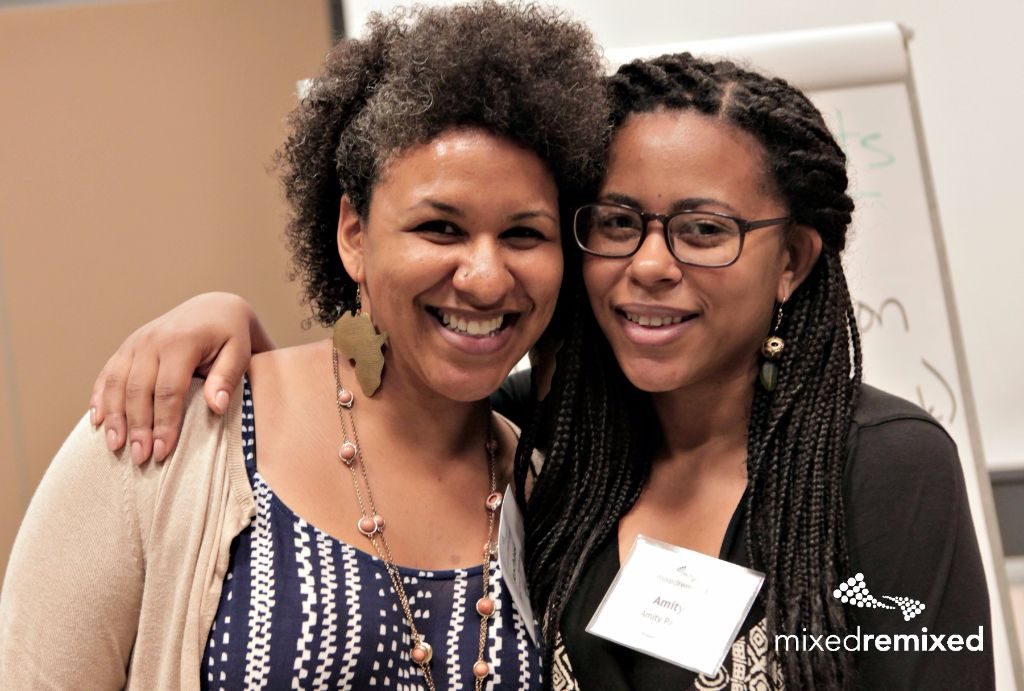 We wound down the workshop with the sharing of our findings and insights from the mingle huddle activity. Rachael noted that being able to share stories is important first because of its ability to build the sense of community from which we can work, and is actually a form of activism itself: the act of holding space for people and allowing for the complexity of their stories without having to interject or tell them how their story is similar/dissimilar to ours.
We wound down the workshop with the sharing of our findings and insights from the mingle huddle activity. Rachael noted that being able to share stories is important first because of its ability to build the sense of community from which we can work, and is actually a form of activism itself: the act of holding space for people and allowing for the complexity of their stories without having to interject or tell them how their story is similar/dissimilar to ours.
We can’t organize against racism, Rachael pointed out, if we are not in relationship to each other, which is why knowing how to listen and create safe spaces for each other is crucial. We closed on a reflection of how our stories shared today can affect communities and offer opportunities of healing. By the time the group was filing out of the room, budding friendships had been forged and a strong sense of community hung thick in the air. It never fails, Amity said, that through creating this space and sharing stories, people connect in amazing ways, sort of that “Oh my god—I can’t believe I found you!” moment. And I concur—I can’t believe I found this workshop.
Note: If you’d love to learn more about their amazing work, while Amity and Rachael do not presently have websites, any requests for consultation or training can be sent to Rachael at assist.rachaelibrahim@gmail.com
~Michele Beller, Festival Blogger, https://randomaunt.wordpress.com/
Naming the Monsters: Christina Guillen on Teaching Microaggression Zine Workshop
We asked Christina Guillen who led the Microaggression Zine Workshop at the Mixed Remixed Festival about her experience. The workshop was a hands-down hit. We are looking at the possibility of doing this workshop again during the year so that more of our Festival followers can experience this. Plus I want to do the workshop too!-Heidi Durrow, Festival Founder
“Festival attendees filled the room. I introduced my background as Mexican and white and gave a definition of microaggression. I explained my story of first encountering the term. I shared my anger and the diffusion of pain upon hearing the word. I proposed to our group we give our microaggressions a shape, smell, or feeling. I demonstrated releasing a rough styrofoam ball on the table. The ball bounced and rolled away. I explained once we can see our microaggression outside of ourselves we can disidentify and observe it. This gives our power back.
 I asked them to offer their own microaggressions. They spoke up shyly at first, but eventually there were enough responses to see an array of reactions. Some spoke with humor others let their anger and frustration be heard. It got pretty intense but I was prepared. I let them know it was a safe place, we’re in the same boat. We have a right to feel however we feel. I think the validating was really needed. Even though I’d said I was not the microaggression expert but more of a conversation facilitator, people still looked to me for validation of their feelings, to ask whether their experience was a valid microaggression. Some got tangled up with terms so we talked about what underlies the term microaggression. Our honest feelings underneath it all are telling us something doesn’t feel right. We want to name it because we want to disidentify from it. We went back to the beginning—give the feeling a shape and disidentify.
I asked them to offer their own microaggressions. They spoke up shyly at first, but eventually there were enough responses to see an array of reactions. Some spoke with humor others let their anger and frustration be heard. It got pretty intense but I was prepared. I let them know it was a safe place, we’re in the same boat. We have a right to feel however we feel. I think the validating was really needed. Even though I’d said I was not the microaggression expert but more of a conversation facilitator, people still looked to me for validation of their feelings, to ask whether their experience was a valid microaggression. Some got tangled up with terms so we talked about what underlies the term microaggression. Our honest feelings underneath it all are telling us something doesn’t feel right. We want to name it because we want to disidentify from it. We went back to the beginning—give the feeling a shape and disidentify.
I passed around a bucket of shapes (screws, sandpaper, scissors, a zipper, a crab’s pinchers, a snarling chihuahua, etc). Each person kept one to represent their feeling as they filled out a worksheet about microaggressions. Later, I showed how to fold a single sheet into a small book. Afterward, the group transferred their ideas from the worksheet onto the zine book. They created with markers, stencils, and drawings. The result was a zine that physically showed their experience outside of themselves. Titles ranged from “You don’t like beans?” to “Don’t touch my hair!” to “Zen in the face of microaggression.”
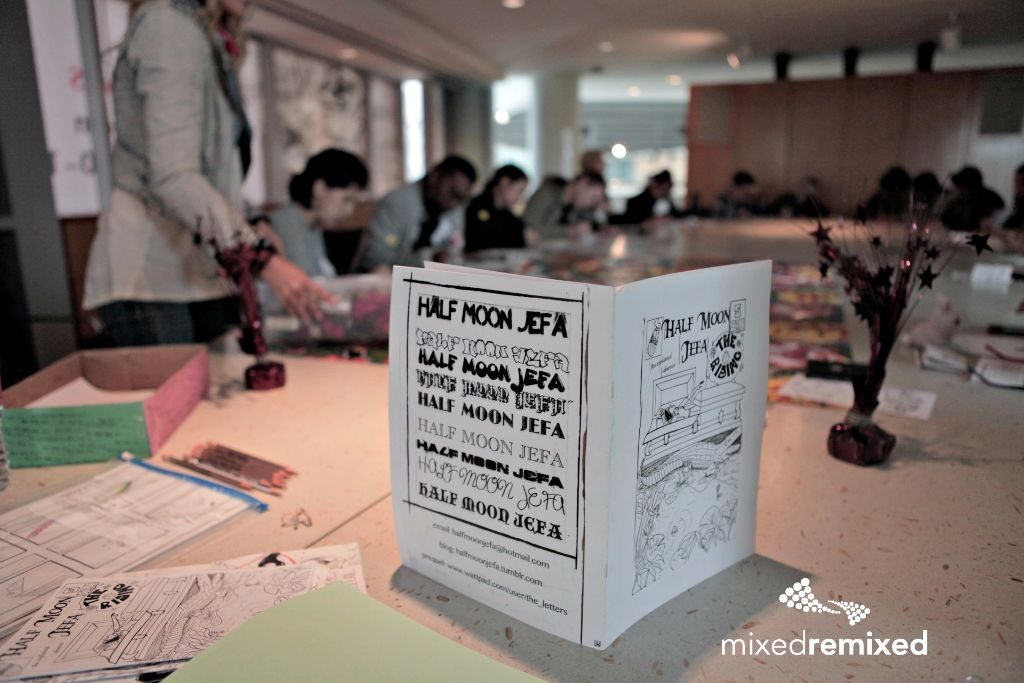 The actual creative process allowed us to keep the conversation going while our hands were occupied. We talked about that many minorities transcend their experiences by doing creative projects. Myself and another woman wrote a novel, another sings, and all of us made a zine. We talked about seeing the positive angle of microaggressions, we found ways it was making all of us better more loving people.
The actual creative process allowed us to keep the conversation going while our hands were occupied. We talked about that many minorities transcend their experiences by doing creative projects. Myself and another woman wrote a novel, another sings, and all of us made a zine. We talked about seeing the positive angle of microaggressions, we found ways it was making all of us better more loving people.
At the end I suggested leaving their zine in their car as a communication tool. Several said they’d like to do so. I was overjoyed with the smiles, hugs, gratitude, and relief I felt in the room. It was an amazing feeling to validate and empower so many people! I think I’m still glowing.”-Christina Guillen
Christina Guillén is a diversity speaker, teacher, writer and the creator of Half Moon Jefa, the Mixed People’s Superhero. Her historical fiction novel and M.F.A. in Creative Writing focus on identity, feminism, and indigineity vs. colonialism. Christina will lead an exciting hands-on zine workshop to flirt with our perspectives on the topic of microaggressions. Find out what trucos she’s up to at halfmoonjefa.tumblr.com.
Microaggression Zines for the Multiracial Soul
Microaggression Zines for the Multiracial Soul
 When I walked into the Yuki Family Board Room of the Japanese American National Museum at the 2016 Mixed Remixed Festival where the Microaggression Zine Workshop was being held, I’ll admit that I wasn’t entirely sure what to expect.
When I walked into the Yuki Family Board Room of the Japanese American National Museum at the 2016 Mixed Remixed Festival where the Microaggression Zine Workshop was being held, I’ll admit that I wasn’t entirely sure what to expect.
The description in the Mixed Remixed Festival Program sounded inviting: “Naming and understanding the little monsters [microaggressions] can bring back an immense sense of personal peace and power.” I was intrigued. Personal peace and power? Sign me up. The workshop was led by Christina Guillén, a diversity speaker, teacher, and writer. You can see a picture of the poster she created for our workshop and learn more about her at . This will give you a hint of the fun she had in store for us workshop attendees. (Christina is also writing a fascinating historical fiction novel set in sixteenth century Mexico, focused on identity and indigeneity vs. colonialism—you can follow along with her prequel, a series of online letters written back and forth by the novel’s characters at https://www.wattpad.com/user/The_Letters.)
Microaggression and the Mixed Race Experience
Are you wondering what a microaggression is, exactly? A lot of us were. This was the first thing Christina addressed when the workshop began. She offered a definition and then went around the room and asked each of us to add to  the conversation by offering our understanding. The room was buzzing with talk and discussion; Christina is a delightful workshop leader and made all of us feel warmly accepted and eager to learn more. The term “microaggression” has been around for a while; Random House dictionary describes it this way: “a subtle but offensive comment or action directed at a minority or other nondominant group that is often unintentional or unconsciously reinforces a stereotype: microaggressions such as ‘I don’t see you as black.’” For mixed race people like me, a familiar one is that pesky question, “What are you?” or “Where are you from—no, originally, where are you from?” All of the workshoppers were excited at the notion that we could use these zines to, as Christina suggested, “flirt with our perspectives on the topic of microaggressions.”
the conversation by offering our understanding. The room was buzzing with talk and discussion; Christina is a delightful workshop leader and made all of us feel warmly accepted and eager to learn more. The term “microaggression” has been around for a while; Random House dictionary describes it this way: “a subtle but offensive comment or action directed at a minority or other nondominant group that is often unintentional or unconsciously reinforces a stereotype: microaggressions such as ‘I don’t see you as black.’” For mixed race people like me, a familiar one is that pesky question, “What are you?” or “Where are you from—no, originally, where are you from?” All of the workshoppers were excited at the notion that we could use these zines to, as Christina suggested, “flirt with our perspectives on the topic of microaggressions.”
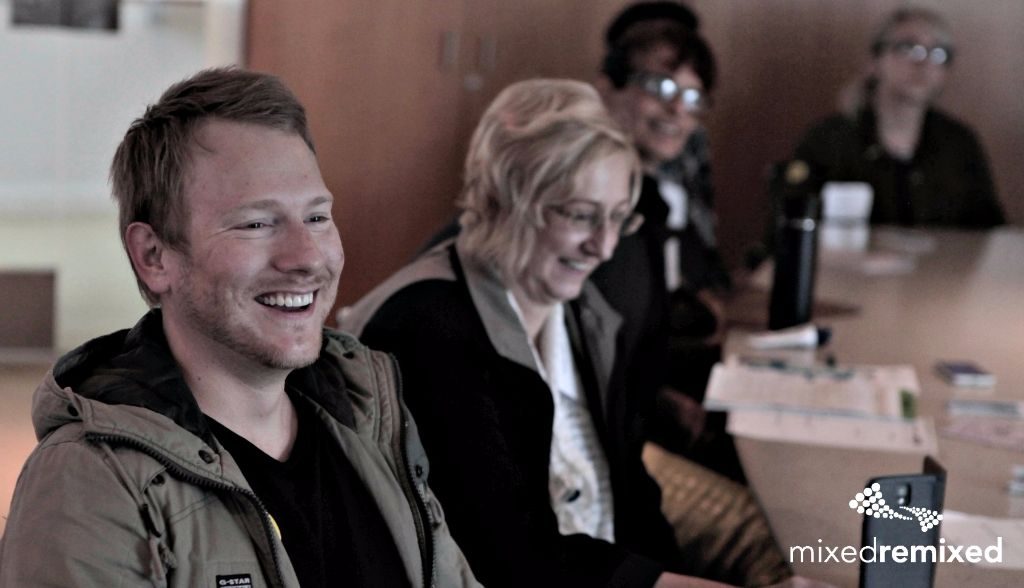 Another great conversation the group had was the sharing of how we each tend to react or handle microaggressions when we are on the receiving end. As we went around the room, the reactions people described ran the gamut, from angry to confused to embarrassed to shamed. One workshopper had a great approach: humor. He explained that his approach was to play right along with the offender, replying and continuing the conversation in a manner that increasingly showed the absurdity of the comment or act, until the person realized his/her folly and the tables had turned. Note to self, I jotted on my notepad. Must try.
Another great conversation the group had was the sharing of how we each tend to react or handle microaggressions when we are on the receiving end. As we went around the room, the reactions people described ran the gamut, from angry to confused to embarrassed to shamed. One workshopper had a great approach: humor. He explained that his approach was to play right along with the offender, replying and continuing the conversation in a manner that increasingly showed the absurdity of the comment or act, until the person realized his/her folly and the tables had turned. Note to self, I jotted on my notepad. Must try.
What’s a Zine?
Once the group felt clearer about microaggressions, we were ready to dig in to the zines. At the beginning of the workshop, Christina had given each of us some samples of zines she had created—they are, simply, handmade mini-magazines. She handed out outlines with prompts that we would answer out as we fleshed our zines. Then she passed around a plastic container full of odd and eccentric items that we could go through and pick out, with the idea that this was added inspiration, visual, tactile, and most definitely creative! Some of the items included, for example, sandpaper, big floppy silk flowers, a rock, a small ceramic mask, and a little hammer. I chose the little hammer—don’t ask!
Once we got to work, Christina turned on some background music to help feed our creativity, wonderful Afro-Latin jazz type music that had me groovin’ and the whole room buzzing. Christina had promised we would “light up with creative excitement” as we processed confusing experiences that made us feel funny or awkward, and I’ll confirm: that boardroom was ablaze with energy! As we worked, a great scene of laughter, sharing, and sheer genius ensued. Once we had our outlines done and our tools laid out in front of us, Christina taught us how to take a plain 8 ½ by 11 sheet of paper and fold it until it turned into a mini book, sort of origami-style. We were rolling now! Meanwhile, Christina had spread a mini-toy-store of creative grown-ups’ utensils across the table —colored pens and pencils, crazy, fun stencils (like bats and ghosts) and more (I chose a dinosaur for my stencil).
Ready for Publication!
Growing up biracial with two parents who firmly believed and taught me that “race” is a social construct, I had no idea when I got older and went out in the world how to manage the microaggressions that were directed at me. Christina offered a wonderful, empoweri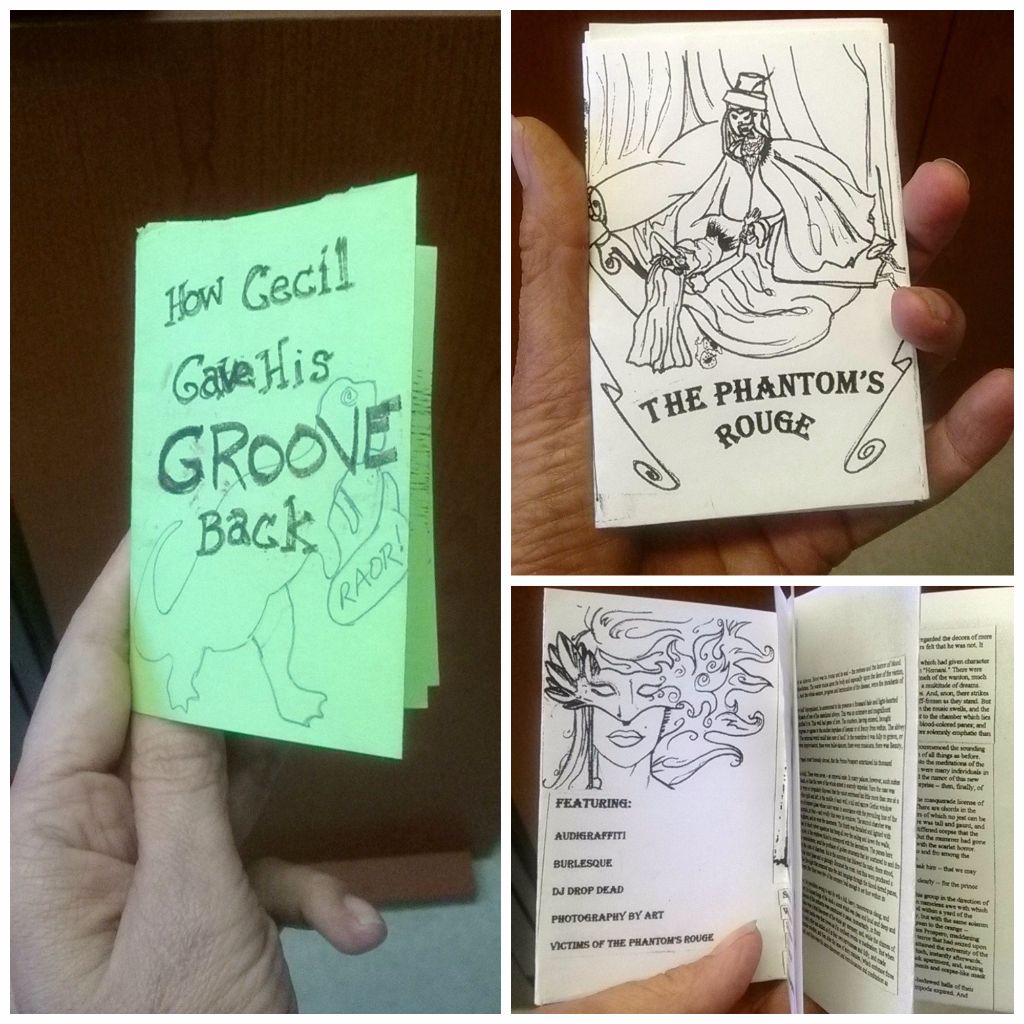 ng, therapeutic strategy for managing these inevitabilities of multiracial life. As our time together neared its end, the group, now feeling extremely comfortable and collegial, went around and shared what they had created. No one wanted to leave. Christina had promised us that we would “leave with a new positive experience to associate with microaggressions, and a hands-on tool to help us better understand how conscious and unconscious behaviors like microaggressions affect us Earthlings.” She didn’t disappoint.-Michele Beller, Festival Blogger
ng, therapeutic strategy for managing these inevitabilities of multiracial life. As our time together neared its end, the group, now feeling extremely comfortable and collegial, went around and shared what they had created. No one wanted to leave. Christina had promised us that we would “leave with a new positive experience to associate with microaggressions, and a hands-on tool to help us better understand how conscious and unconscious behaviors like microaggressions affect us Earthlings.” She didn’t disappoint.-Michele Beller, Festival Blogger
This is one story in a series about the programs held at the Mixed Remixed Festival 2016. Please read through them all by searching our blog with “2016 Festival Re-Cap.”
Loving Day petition, Mixed Remixed and the whole story on NBC News!
 We were so excited to see this awesome story by NBC News about Ken Tanabe’s efforts to get Loving Day recognized as a federal holiday as well as featuring Loving Day celebrations across the country including the Mixed Remixed Festival!
We were so excited to see this awesome story by NBC News about Ken Tanabe’s efforts to get Loving Day recognized as a federal holiday as well as featuring Loving Day celebrations across the country including the Mixed Remixed Festival!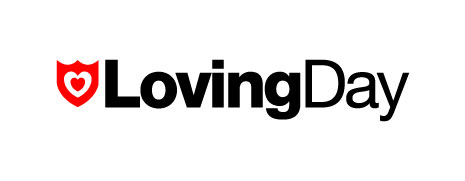
We hope that you will take five seconds and sign the petition so that President Obama will address the question. This is the time! We need you to sign your names by June 30! Hurry. Sign here.
 ‘Loving Day’ Petition Launched in Hope of Broader Recognition
‘Loving Day’ Petition Launched in Hope of Broader Recognition
by SYLVIA CUNNINGHAM
When Heidi Durrow gets sent articles from the Google Alert she set up for “mixed race families,” it’s usually not very good news.
Durrow, author of the New York Times best-seller “The Girl Who Fell From the Sky,” said oftentimes she’ll see lists of “all the things multiracial people don’t want to hear,” or backlash towards companies like Old Navy for featuring an interracial family in an advertisement.
“I think it would be great to have a national spotlight on the ways in which we’re all connected and give us an opportunity to celebrate that for a moment as opposed to just talking about it when it becomes a flashpoint for hatred or anger or violence,” Durrow said.
Ken Tanabe, who founded Loving Day in commemoration of the landmark Supreme Court case which struck down laws banning interracial marriage, is one person fighting alongside Durrow to make that wish a reality.
At the end of May, Tanabe launched a petition to make Loving Day, celebrated annually on June 12 in honor of the decision date of Loving v. Virginia, a federal observance. The petition requires Tanabe to get 100,000 signatures by June 30 to receive a response from the White House. The designation of Loving Day as a federal observance can come from either Congress or from the president. READ THE REST OF THE ARTICLE HERE!
Hundreds Gather in Downtown LA to Celebrate Stories of Mixed-Race and Multiracial People & Families

We were so excited to see this story about the Mixed Remixed Festival that appeared in the LA Times last weekend, June 12, 2016. Reporter Anh Do perfectly captured the meaning, the vibe and the experience of the Festival. Please check it out!-Heidi Durrow, Festival Founder
 Hundreds head to downtown L.A. for nation’s largest gathering for multiracial people
Hundreds head to downtown L.A. for nation’s largest gathering for multiracial people
by Anh Do
Their eyes shimmered with tears when embracing the “others.”
But this gathering — the nation’s largest for multiracial people held Friday and Saturday in downtown’s Little Tokyo — would not be graced with sadness.
“We’re here to celebrate. You look around you, you see not only your identity, but countless identities,” said founder Heidi Durrow of the Mixed Remixed Festival, in its third year, drawing nearly 1,000 participants.
“When someone meets someone like us, they always say, ‘What are you?’ ” Durrow said. “Based on our faces, they form expectations. That’s why we invite them to move beyond images to hear our stories — then let’s share everyone’s stories.” . . . Click to read the rest in the LA Times.
Join us for the largest gathering of multiracial and mixed-race families and people and GET GREAT STUFF. FREE!
 Giveaways will be happening all day long on June 10th & 11th! 😉
Giveaways will be happening all day long on June 10th & 11th! 😉
There are also 100 Mixed Remixed gift bags that will be given to the first 100 attendees!
🎈 At the festival, you will have the chance to win the following prizes: 🎈
- 2 Amusement Park Tickets
- A copy of “Loving Day” by Mat Johnson
- A Gift Card to Total Wine & More
- A Gift Card to Benihana
- A Mixed Chicks Gift Basket
- A Whole Foods Gift Basket
- Official Mixed Remixed T-Shirt
- A Mixis Living doll
- A MyFamilyBuilder™ Toy Set
Remember there are also 100 Mixed Remixed gift bags that will be given to the first 100 attendees!
Loving Day Reception to Celebrate Multiracial Americans and Mixed-Race Families
We’ve got the largest West Coast celebration of Loving Day going on and we hope that you’ll join us!
 Celebrate Loving Day at our Loving Day Reception Saturday June 11 starting at 5:30pm. It’s FREE! A wine and cheese reception kicks off the night (yes, the wine, beer and cheese are FREE too!) at
Celebrate Loving Day at our Loving Day Reception Saturday June 11 starting at 5:30pm. It’s FREE! A wine and cheese reception kicks off the night (yes, the wine, beer and cheese are FREE too!) at  5:30pm. The Storyteller’s Prize Presentation and Live Show starts at 6:30pm and wow what a show it is! Check out the line up here.
5:30pm. The Storyteller’s Prize Presentation and Live Show starts at 6:30pm and wow what a show it is! Check out the line up here.
Film/TV Star Taye Diggs and Shane Evans To Be Honored for Mixed Me!
We’re honoring Taye Diggs and Shane Evans for their awesome book Mixed Me! And yes, the show is FREE too!

Immediately following the show, we will have a short dessert reception and our Storyteller’s Prize Honorees Taye Diggs and Shane Evans will sign copies of their book Mixed Me! Our wonderful bookseller Skylight Books will be on hand to sell copies!
HAVE YOU SIGNED THE PETITION TO MAKE LOVING DAY A FEDERAL OBSERVANCE?
And one more thing: Have you taken 5 seconds to sign the petition to make Loving Day a federal observance? If not do it now! Sign here!
Mixed Remixed: Terri Rogers
Since November 2015, when I began coordinating bloggers for the Mixed Remixed Festival, fellow blogger Terri Rogers intrigued me. At age twenty-four, I’m still grappling with my many selves and seeking a sense of progressive direction. Terri graduated from high school in 2014, and she’s searching for her place in the world, too. But she’s much more Zen about the “adulting” quest than I am. Maturity isn’t necessarily tied to age, and I think we all need to learn from people like Terri. I hope the below interview enlightens you like it enlightened me.
- What do you like best about blogging for Mixed Remixed?
The creative freedom it gives me to truly write and share my experiences on what it means to be mixed. I am so happy to be part of a team with other writers and bloggers of varying backgrounds who are always inspired, motivated, and driven to constantly keep the conversation of “mixed-race” going. They truly inspire me to want to be a better writer and a greater team player. Having the opportunity to FREELY write about my personal journey for such a meaningful festival in this community is truly amazing and I’m beyond grateful.
- The cohesion among groups is often attributed to a shared experience or set of shared values. To what extent, if at all, do you think that there is a shared “mixed race experience” or “mixed-race values”?
I think that because many people, even within our own mixed families, have a hard time understanding our position and how we experience things a bit differently than they might—the shared “mixed-race experience” is just that: we get IT. We understand not fully fitting in on either side; being too “this” for that group or too “that” for this group and being very conflicted and unsure as to where we fit in this great big world. On the other hand, we also understand the beauty of growing up between two cultures and races (or whatever the mix happens to be) and being able to appreciate both sides and how that makes us all unique but also brings us all together—all at the same time.
- How did you learn about the Mixed Remixed Festival, and how did you first become involved?
I found a channel on YouTube by a blogger named Tiffany Jones, who had a series called “The Mulatto Diaries,” and she included a clip of the Mixed Remixed Festival with Karyn Parsons (Fresh Prince of Bel Air) and I remember thinking to myself: “How cool! There’s a place where mixed people can get together and just…embrace our ‘mixedness'”? I then Googled the festival and saw that you could volunteer on the blogging team and almost immediately, I sent an email with my interest and before I knew it, Heidi herself responded and before long we set up a Skype interview and the rest is history! Thank God for Tiffany! 🙂
- Where do you feel more freedom to be your “whole” self—in America, or in Germany? How do you think Europeans view race and “mixing” in contrast to how Americans seem to?
Well, to be honest, I’ve only been to America once in my entire life (say whaaat?). I remember being very nervous to visit my dad’s side of the family in Arizona for an irrational fear of rejection or some type of racial tension. To my everlasting surprise, it was one of the best trips ever—cousins I had never met wanted to take me to school with them for the day! It was one of the best feelings, just being considered part of the family—I felt silly for being so nervous! The overall trip was really great as well, I didn’t encounter the racism I thought was waiting for me. It was just my Afro-Caribbean mother and me (my dad couldn’t come) and they were all so open and were so happy to meet their “beautiful little cousin from Tobago.” In Germany, it’s been fairly mixed actually: some people genuinely don’t care about interracial relationships, while some tend to be slightly uncomfortable about them. Germany continues to become somewhat of a melting pot with people from neighbouring countries living here, so in the main cities, there isn’t a “strictly” German experience here—this has its pros and cons of course. I think, though, that Germans view race very simply, very black and white—the grey area isn’t often recognised; so in a sense the mixed community here is facing a similar issue but definitely not as “in your face” as it would be in the U.S.
From all the stories on social media as well as from films and news reports, America seems to have a major issue with mixing the races and “losing” some form of identity and the “purity” of a said race. I can’t deny the fact that some Germans also have a fear of becoming too multi-cultural and losing their identities in these changing times. Generally speaking though, I think Germany is much more open and are less overtly racist than you may find in the States. Now this is merely from my experience and what I’ve heard from Americans, as well as what I’ve seen and read in the media. It really depends on whom you meet. 🙂
- If you could give advice to your younger self regarding your ongoing search for a reconcilable identity, what would that be?
Don’t worry about it so much! Don’t let people’s curiosity and issue with “what” you are affect the way you see yourself and interact with others. Explore every aspect of yourself and let it come naturally—don’t force anything. Stay true to yourself, stay true to the “you” you were before you realised how heavy race was in our world. “Be soft. Do not let the world make you hard. Do not let pain make you hate. Do not let the bitterness steal your sweetness. Take pride that even though the rest of the world may disagree, you still believe it to be a beautiful place.” —Kurt Vonnegut
- What do you think holds more weight—culture, or the construct of race, and why?
That’s a really great question. I would like to say culture because in the Caribbean for example, it’s a huge melting pot. You have people of European, African, and Asian descent (and well everything in between) and over the years, our cultures have all merged and more or less become one: Caribbean. The Jamaican motto sums it up perfectly, “out of many, one people.” However, it would be naïve to say that we do not have issues related to race—because, sadly, we do. Culture tends to bring us all together on the surface and can at times, I’ve seen, be very superficial even. Another example could be white rappers: they may be part of the “culture” but still, there will almost always come a time when we have to mention the fact that said rapper is “white.” So I would definitely say that in a general, global sense, race definitely holds more weight: it’s seemingly the most identifiable and unmistakable of all traits and definitely has a role in shaping culture and its values.
Terri Rogers, everyone—what a wise young woman. You can follow Terri online, on her blog, One Love, and on YouTube.
The Art of Reclaiming
Mixed remixed
We are remixing our mixedness
Say no to mixed up
Say yes to mixed in
Yes to the prefix
Re: re-
the progressive form
Resisting, Reactivating, Repurposing
Reclaiming
Recapture what was once ours
the words the morsels the rocks the names
We are more
than our parts
Yes we are our parts
Separate together
Bi- tri- multi-furcated
Yet swirled jumbled bled into one
Whole is where the heart is
Split is where the view is
Question where the answer should be
Does it bother you
My breaking the form
Breaking from form
Taking form
Pop open my head
Glimpse inside
at the highways of my jammed mind
Tell me it’s so
I won’t let it
Gone are the days
I listen to the dictates of others
without weighing
My feelings
on one side
My thoughts
on the other
I help me help myself
I help me unhurt
I measure and remeasure
My own self-worth
Because
I belong to me
I am a story
I am a series of stories
I exist on many planes
You don’t need to get
on my board
on my level(s)
with my program
I hope you might
Try care think to listen
But the truth is
Here’s me without you
See me, un-see me, re-see me
Here, there, where
I want dream plan to be
Chant with me
if you dare
Re, re, re
Find me at the intersection
of intersectionality
Find me at the joining
of re- and claiming
I am—
the art of reclaiming
—Joy Stoffers, Festival Blogger

